This post contains affiliate links. We may get paid an affiliate commission if you buy something or take an action after clicking one of the links on this web page.
Last Updated: August 3, 2019
It’s been my experience that the deeper my understanding of something goes, the less things of that something I like. To use my perennial dead horse as an example, years ago when I first started carrying and using knives, I thought the Delica was wonderful. However, over time as I filled my head with more and more minutiae about knives, and as my opinions about design and use became more developed, the Delica fell further and further in my esteem. As our taste gets better, it gets more and more specific (non-enthusiasts call this phenomenon ‘snobbery’).
I’ve always considered myself a passionate layman when it comes to flashlights. They’re a very useful part of an EDC setup, something that I don’t like to go without, but my taste in flashlights hasn’t reached the rarefied air that my knife-sense has. Whereas with knives I’ve gone from “Does it cut?” to “Does it cut well?,” when I’m looking at flashlights I’m still just asking “Does it light up?”
So you’ll have to take my recommendation of the Streamlight Microstream with the proverbial grain of salt. And I do recommend it. Although it has been around for years with little real evolution, and although even a mediocre enthusiast flashlight smokes it in most categories, for what it is – and, to be fair, for what it costs – the Microstream is a perfectly adequate and charming little light.
General Dimensions and Construction
Whatever its other faults, the Microstream is just about the ideal size, for me, for EDC. It’s about 3 7/16” long, and, at its widest point, is about half an inch across. Streamlight lists the weight with battery as 1.04 oz., although by my scale I was getting 1.3 oz. or so – not a world-shattering difference by any means. It takes one AAA battery.
The Microstream has a by-the-books Type II anodization job. It looks clean and consistent out of the box, but in the testing period for my Microstream it started to show wear quickly. Nothing egregious, just a scratch here and there, but quicker than my Peak Eiger began to show wear.
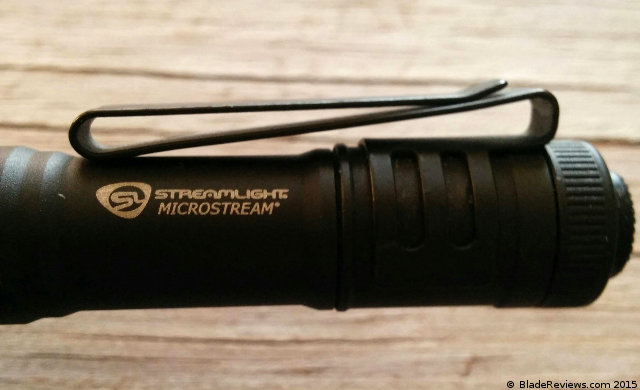
Less conventional is the Microstream’s clip. First, it is a friction-fit clip. Folks tend not to like friction-fit clips because they can get loose or knocked off during carry. I can tell you that the clip on my Microstream is extremely snug – so snug, in fact, that for a long time I thought it was actually part of the body and just looked like a friction-fit clip. The clip itself is made of a fairly thin leaf of spring steel, folded twice over to create an S shape, so that you can clip it either to your pocket as you would a knife, or to the brim of a hat or something for hands-free operation. I’ve never used this feature, but it is unobtrusive, and I like to think that extra fold of steel gives the clip some added durability.
Beyond these specifics, the fit and finish of the Microstream is more than adequate: the emitter is centered, the lens is free from blemishes, and the threads come apart and together without any dramatics.
Output, Runtime, and UI
It is in the fields of output and runtime that we really see the difference between the Microstream and current, higher-priced enthusiast products.
The Microstream has an out-the-front output of 28 lumens. The Foursevens Preon 2 can throw out 84, the Olight i3 gives you 80, the L3 Illumination L10C; the recently-released Olight S1 Baton goes all the way up to 500 lumens.
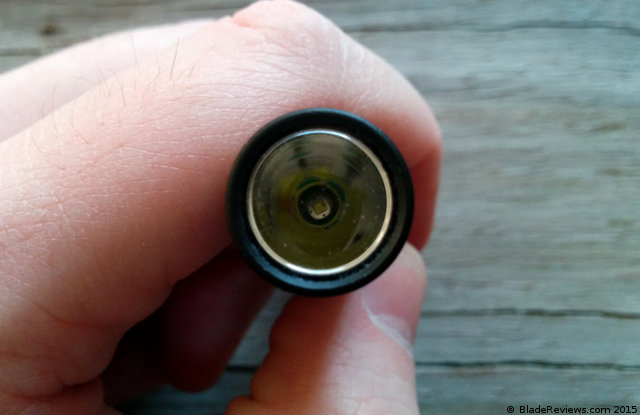
The Microstream is totally obliterated by its competition in terms of output, but beyond that it also doesn’t have different modes like most lights today: it’s either on at 28 or it’s off. Runtime is equally underwhelming at 2.25 hours. This wasn’t blowing wind up anybody’s skirt five years ago, and time has only increased the gap between the Microstream and its competition.
I’m going to say something, and I’m going to risk sounding reductive when I say it, but: 28 lumens is plenty good enough for most EDC situations, isn’t it? This is my dog-walking flashlight, as well as what I use when something rolls under the bed or a chair, and in these roles I get all the light I need – and I’ll go so far as to say that, for being only 28 lumens, it is a very bright 28, and has a good bit of throw for as small of a light as this is. The beam pattern isn’t all that it could be, though: a lot of artifacts and rings.
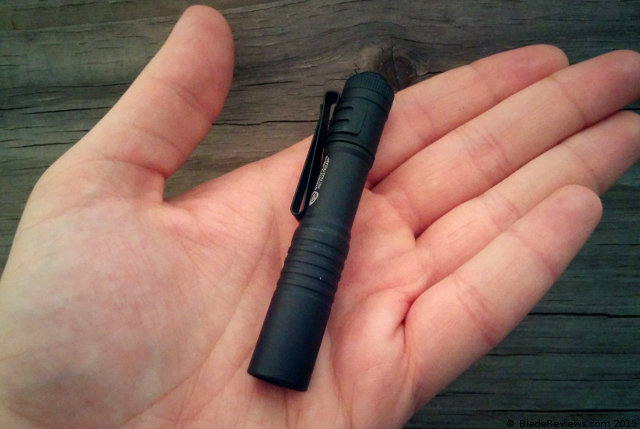
It helps that I like the UI. I prefer clickies generally; I find they are easier to operate with one hand. The Microstream’s clicky has a fairly tough plunger, and takes a bit more force than you would expect to switch on, but this is mitigated by a momentary-on feature that turns the Microstream on temporarily, for however long you keep the clicky semi-depressed. This is the way I use the Microstream most of the time, and I like it a lot.
Ergonomics and Carry
The ergonomics of the Microstream, like the light in general, are pleasingly adequate. Not totally stellar: the anodizing doesn’t afford quite as much traction as I would like, but it works. The ‘cigar grip’ puts your thumb comfortable over the clicky, and the Microstream’s length is such that holding it in your fist doesn’t occlude the light at all.
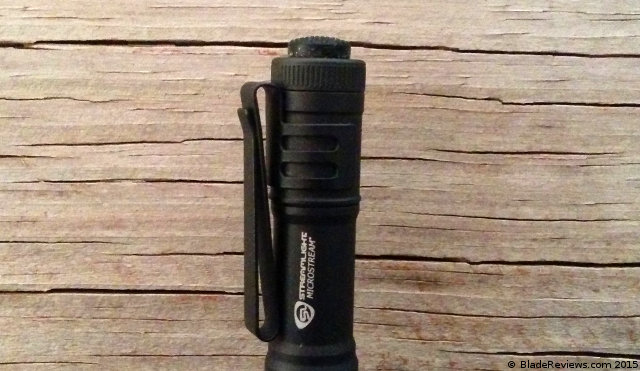
The Microstream carries quite well. I don’t know how you guys like to roll, but clipped to the front of my pocket, the Microstream is easily accessible, doesn’t mess with my pocket knife, and doesn’t impede my hand when I go into my pocket for something else. Most pocket flashlights are too rotund for me to want to have them clipped to my pocket (I’m thinking of the HDS Rotary or the Olight S1 here), so they get carried loose, which is not ideal. The Microstream, with as small and slim as it is, carries just about perfectly clipped to my pocket.
If you prefer to carry your lights loose, however, I think you’ll find the Microstream to be a well-behaved passenger. It fits into a watch pocket if you want to keep it somewhere away from coins and other riff-raff.
Streamlight Microstream Review – Final Thoughts
There are a lot of areas in which the Microstream could be improved. That being said, I find it remarkable that in a world in which things like the S1 Baton or the L10C (or, my personal favorite, the Peak Eiger) exist, there is still merit in a product like the Microstream.
A lot of that merit comes from its agreeable price: while there are a lot of awesome lights to be had at the $30 – 50 range, there isn’t any light that I know of that costs as little as the Microstream, and that is as good. If there be such a thing as a ‘beater light,’ than the Microstream is it; it gets the job done, soaks up abuse, and doesn’t offend in any part of its design.
I know this is a hard sell for enthusiasts, but if you’re looking for something simple to tide you over between flashier (ha ha) purchases, the Microstream is worth a look. For somebody looking for a good first flashlight, something with dignity, but that isn’t prohibitively expensive, the Microstream should be on their shortlist.
I own strictly better flashlights than this and still like to carry the Microstream every once and while. It is simple, functional, and affordable, and I recommend it.
- Type II MIL-SPEC abrasion and corrosion-resistant anodized aircraft aluminum construction with unbreakable, scratch-resistant polycarbonate lens
- Ultra compact design fits in the palm of your hand, comfortably fits in your pocket
- Type II mil spec abrasion and corrosion resistant anodized aircraft aluminum construction with unbreakable, scratch resistant polycarbonate lens
- Removable pocket clip also clips onto brim of hat for hands free use
I recommend buying the Streamight Microstream at Amazon.
Editor’s Note: Well, it only took 200 or so posts, but we have finally reviewed something besides a knife. I think it’s a nice change of pace, and Ben and I agreed that the Microstream is a good starting point for a library of flashlight reviews. Expect more flashlight reviews (and reviews of other pieces of gear) in the not so distant future.
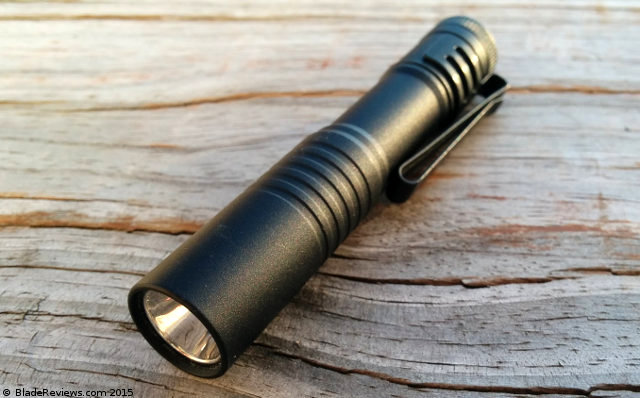
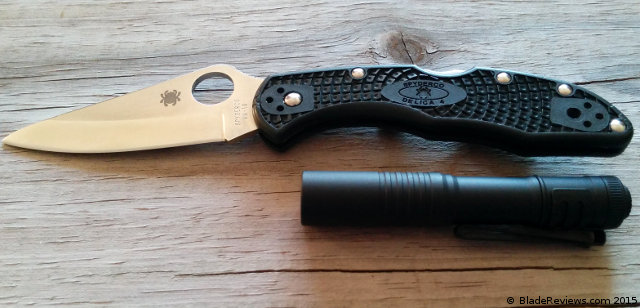

Excellent review.
I have used one of these for several years and while 28 lumens doesn’t sound like much, I’ve found it to be more than adequate for virtually every situation where I’ve used it, including walking over rough terrain in the dark. It’s so small that it’s easy to carry all the time, everywhere. I have to replace the battery only about once a month.
Thanks Will! Glad you enjoyed it.
What fun! The review totally pegs the spirit of the Microstream.
I have a soft spot for this little light. It is the flashlight equivalent of the Kershaw Crown: humble, yet dignified in the way it accomplishes its simple task well. Delivers what was promised. For circa $15 you just cannot complain.
I’d note that current editions of the Microstream have an upgraded output of 35(!) lumens. In my experience the regulation is decent too. No one would mistake it for a Fenix but it’s better than other Streamlight products. One thing I like about SL is they always include an output graph and they tend to be dead honest.
You can expect a legitimate 2 hrs of useful medium output from the Microstream using a garden variety hardware store alkaline AAA.
I like the pocket clip both worse and better than Ben did.
Worse, because in its normal use, I don’t find it secure enough on the hem of a jeans pocket, and since I usually carry lights clipped to a back pocket, that matters. I lost my old 28 lumen Microstream during ordinary activities. It matches a bit of a motif I spot among other reviewers, that these things can go wandering. They do better if clipped in the front or dropped in pocket.
Better, because it has a special use that works GREAT. It is a 2-way S-clip designed to be clipped to the front of your ballcap, and it truly pwns in that role. (As the Late Boy Scout puts it in his review, “…since you’ve got your ballcap on…”) It’s a simple, useful, cheap approach to hands-free lighting. In and of itself that trick is worth throwing a Microstream in your glove box in case you need to change a tire at night. Makes all the fussy Fenix and Foursevens headstraps etc. seem inelegant.
BTW that stiff clicky is a rarity in modern EDC lights, a genuine tactical-style forward clicky. They are meant to be stiff because the momentary-on is the primary function. It is another great feature, even if it is a little amusing to find it on this tiny 35 lumen beam monster.
I wish Fenix, Surefire, Foursevens et al. would give us more options that feature (1) fairly stiff forward clicky (most of the “enthusiast” brands they moon over on CPF use creampuff clickies) (2) one and only one button, which belongs on the tail of the light, not somewhere off on the side of the bezel; and (3) no more than two or three modes; preferably configurable to mono-mode, high-only. That is a self-defense light.
Anyway, I got off subject. Really enjoyed the review. I think the Microstream and the Fenix E05 excel equally as little holiday gifts — perfect stocking stuffers for those of us who will have stockings to stuff.
Note that the Microstream can be clipped to a three-year-old’s ball cap too. This is a big hit for hands-free night exploration of the back yard.
Hey R.D.,
Thanks for the excellent comment! I’m glad you were able to offer some opinions on the reverse clip aspect of the Microstream. Me, my head is too big for a standard human hat, so I don’t even own a cap to try it out on. You’re right: it is an elegant solution to a problem most other companies seem to address with head-straps and other goofy paraphernalia.
You sum it it up best when you say that it’s “humble, yet dignified in the way it accomplishes its simple task well.” That humble dignity is what sells me on the Microstream.
Ben.
Cool review, I’d been carrying around a little “no-name” generic flashlight for a while but it finally died on me, so I’m giving this bad boy a shot as it’s pretty much exactly what I’m looking for.
You might take a look at the Nitecore Tube in this kind of category. It’s a good example of how far technology has come. It won’t have the throw of the Streamlight, but has some nice, easily accessible features that the Streamlight doesn’t, it’s significantly smaller and rides well on a keychain, it’s rechargeable using a micro-usb connection and it costs about 10 bucks.
I wouldn’t say it’s a direct competitor to the Streamlight, but if you have friends or family that aren’t into the EDC things the Tube is a great gift because they can slap it on their keychain and forget about it until they need a light.
I personally carry a Microstream as a beater work light but for more lumens try the Protac series from Streamlight similar ergo’s to the Microstream
Hey John,
Thanks for the comment! The Protacs are definitely tempting. I do wish they were a little less costly – they aren’t super expensive but there are a lot of other, very tempting lights in that price bracket, like the Olight S1.
There’s now a 4th gen Microstream upgraded to a sizzling 45 lumens!
http://www.streamlight.com/product/product.aspx?pid=144
> dons Ray-Bans
Streamlight seems to be doing rolling upgrades to their staple lights… I wouldn’t say they’re making the outputs legitimately competitive with the enthusiast market, but at least somewhat addressing one of their big Achilles’ heels (the other is regulation). The 2xAAA Stylus Pro, which I recommend as a cheap, super-simple starter EDC for noobs, was recently bumped up to 90 lumens.
What SL needs to do now is upgrade their slightly fancier ProTac 2AAA penlight. Give it a non-laughable high output, something like 110 lumens — and give it the “Ten-Tap” programmability that the other ProTac lights have, so you can circumvent the dumb strobe mode.
I would buy the heck out of that package. It might even get some attention from real torch enthusiasts.
Hey R.D.,
Thanks for the update. It’s good to know that SL, even if they’re not participating in the same market as the enthusiast brands, remains committed to upgrades and enhancements.
I wasn’t familiar with the ProTac but, if you can’t skip the strobe mode that’s maddening. The only way I tolerate weirdo modes is if they’re well-hidden.
On the topic of enthusiast appeal, I think that it would be cool if SL made like one light designed for that market, kind of like how Spyderco (at least originally) marketed the Native as a big box store knife. I like crossover products a lot.
Ben.
The default setup on multimode SLs is high-> strobe -> low. Gack!
That sort of makes sense on a large dedicated tactical light (a lot of cops carry SLs if they don’t want to spring for a Surefire). However it is legit awful on a small utility light like the Protac 2AAA.
The Ten-Tap system lets you change the light to two alternate setups that are much more useful: either high-only or low -> high. The PT 2AAA is the only Protac that lacks that programmability.
Which sucks, because it could be one of the best SL products. It has the firm, simple forward clicky of the Microstream and the other Streamlight AAA lights. This is a big part of their appeal, worth sacrificing lumens for IMO. (Again, I wish the enthusiast companies could get that feature squared away so I wouldn’t have to make the tradeoff!)
The PD36R is the best powerful EDC that I bought from Fenix store, the battery lasts long and it’s very bright given the size is compact.